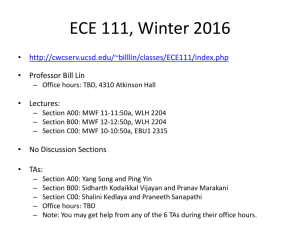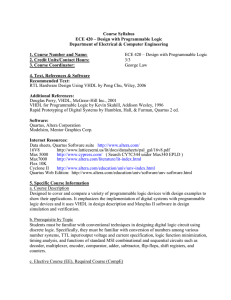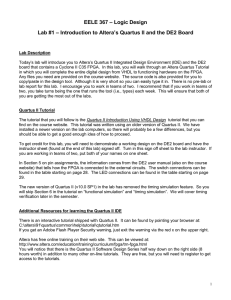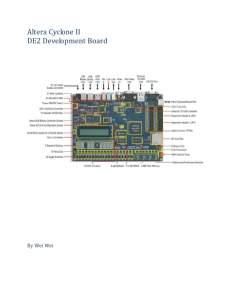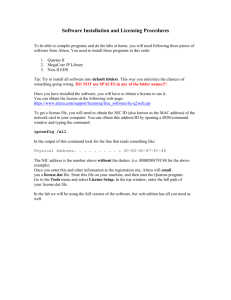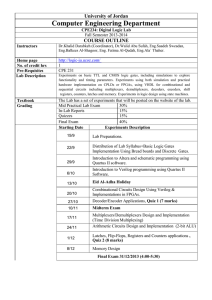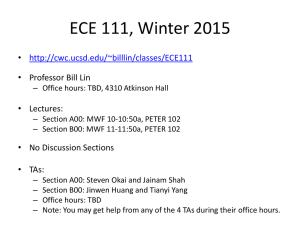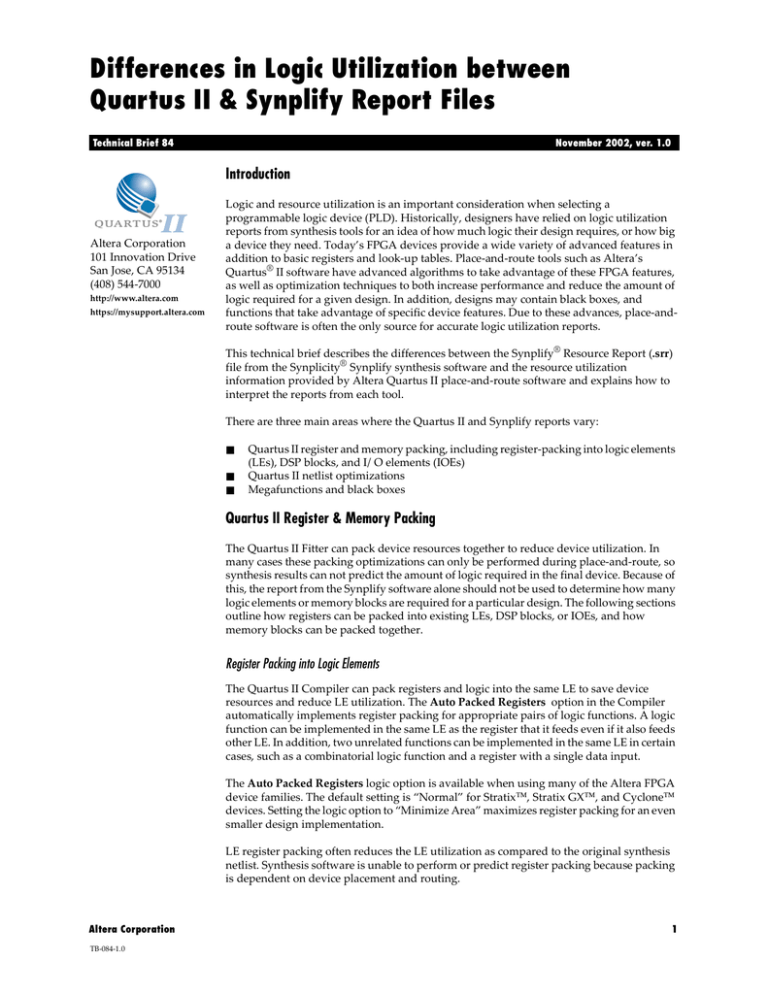
Differences in Logic Utilization between
Quartus II & Synplify Report Files
Technical Brief 84
November 2002, ver. 1.0
Introduction
Altera Corporation
101 Innovation Drive
San Jose, CA 95134
(408) 544-7000
http://www.altera.com
https://mysupport.altera.com
Logic and resource utilization is an important consideration when selecting a
programmable logic device (PLD). Historically, designers have relied on logic utilization
reports from synthesis tools for an idea of how much logic their design requires, or how big
a device they need. Today’s FPGA devices provide a wide variety of advanced features in
addition to basic registers and look-up tables. Place-and-route tools such as Altera’s
Quartus® II software have advanced algorithms to take advantage of these FPGA features,
as well as optimization techniques to both increase performance and reduce the amount of
logic required for a given design. In addition, designs may contain black boxes, and
functions that take advantage of specific device features. Due to these advances, place-androute software is often the only source for accurate logic utilization reports.
This technical brief describes the differences between the Synplify® Resource Report (.srr)
file from the Synplicity® Synplify synthesis software and the resource utilization
information provided by Altera Quartus II place-and-route software and explains how to
interpret the reports from each tool.
There are three main areas where the Quartus II and Synplify reports vary:
■
■
■
Quartus II register and memory packing, including register-packing into logic elements
(LEs), DSP blocks, and I/O elements (IOEs)
Quartus II netlist optimizations
Megafunctions and black boxes
Quartus II Register & Memory Packing
The Quartus II Fitter can pack device resources together to reduce device utilization. In
many cases these packing optimizations can only be performed during place-and-route, so
synthesis results can not predict the amount of logic required in the final device. Because of
this, the report from the Synplify software alone should not be used to determine how many
logic elements or memory blocks are required for a particular design. The following sections
outline how registers can be packed into existing LEs, DSP blocks, or IOEs, and how
memory blocks can be packed together.
Register Packing into Logic Elements
The Quartus II Compiler can pack registers and logic into the same LE to save device
resources and reduce LE utilization. The Auto Packed Registers option in the Compiler
automatically implements register packing for appropriate pairs of logic functions. A logic
function can be implemented in the same LE as the register that it feeds even if it also feeds
other LE. In addition, two unrelated functions can be implemented in the same LE in certain
cases, such as a combinatorial logic function and a register with a single data input.
The Auto Packed Registers logic option is available when using many of the Altera FPGA
device families. The default setting is “Normal” for Stratix, Stratix GX, and Cyclone
devices. Setting the logic option to “Minimize Area” maximizes register packing for an even
smaller design implementation.
LE register packing often reduces the LE utilization as compared to the original synthesis
netlist. Synthesis software is unable to perform or predict register packing because packing
is dependent on device placement and routing.
Altera Corporation
TB-084-1.0
1
TB 84: Differences in Logic Utilization between Quartus II & Synplify Report Files
Register-Packing into DSP Blocks
The DSP blocks available in some Altera FPGA device families have high-speed parallel
processing capabilities optimized for DSP applications. These DSP blocks contain
multiplication, adder, and accumulator logic as well as input, output, and pipeline registers.
If the design contains a multiplier (lpm_mult), multiply-adder (altmult_add) or
multiply-accumulator (altmult_accum) megafunction, or the Synplify software has
inferred such a function from the HDL code, the logic will be placed in a DSP block where
possible. The Quartus II Compiler may be able to pack additional registers from the Synplify
netlist into the registers in the DSP block. As is the case with LE register packing, this
packing is controlled by the Auto Packed Registers logic option. When registers are packed
into DSP blocks, the reported logic usage from the Synplify software may be too high
because it counts an LE for each of these registers that are instead implemented in an
existing DSP block by the Quartus II software.
Register-Packing into I/O Elements
IOEs consist of a single register or group of registers existing next to an I/O pin in a device.
IOEs can help maximize I/O timing performance by permitting fast setup or clock-to-out
times between the pin and the register.
The Optimize I/O cell register placement for timing Quartus II Compiler setting is turned
on by default for some device families. This option directs the Fitter to try to implement
registers in IOEs (rather than regular LEs) to meet timing requirements that relate to I/O
pins (e.g. tSU and tCO). Where this post-synthesis optimization is being used, the logic
estimation from the Synplify software may be incorrect because it counts an LE for each of
these registers that are instead implemented in an IOE by the Quartus II software.
Memory Packing
In some cases, the Quartus II software can automatically pack two independent memories
into one device memory block if the device is running out of memory. For example, the
Quartus II Fitter can pack two single-port logical memories into one dual-port physical
RAM block in Stratix devices (either M4K or M-RAM blocks) if the original design uses too
much memory for the device. Two logical memories can also be packed into one ESB in
APEX II devices. When this memory packing is performed, the overall memory usage for
the design as reported by the Quartus II software may be less than reported by your
synthesis tool.
Quartus II Netlist Optimizations
The Quartus II software includes netlist optimization options to further optimize your
design after synthesis and before place-and-route. These options, turned off by default, can
be applied regardless of the synthesis tool used. When turned on, these options often change
both the logic utilization and the performance of the design. Depending on your design,
some options may have more effect than others.
Netlist optimization features can restructure the data from the Verilog Quartus Mapping
(.vqm) file (generated by the Synplify software) to optimize for placement and routing.
Some of these features use timing information only available after place-and-route, so there
is no way to predict the results during synthesis. Some features may decrease logic
utilization, and some features may increase total logic utilization to improve the design’s
performance. The results depend on the original coding of the design, as well as whether
the Quartus II project is set to optimize for area or speed.
2
Altera Corporation
TB 84: Differences in Logic Utilization between Quartus II & Synplify Report Files
When using advanced netlist optimization options in the Quartus II software, expect
the logic utilization reports from the Synplify software to be inaccurate. The Quartus II
netlist optimization features will generally change the logic utilization that comes out
of synthesis, so you need to refer to the Quartus II report to determine how much logic
was actually used during the compilation.
Megafunctions & Black Boxes
When you use megafunctions or black boxes in your design, the logic utilization reports
in the Synplify software may be incorrect because there is incomplete information
about the function. This section describes how these functions can affect the Synplify
logic utilization report.
Altera provides parameterizable megafunctions that are optimized for Altera device
architectures. Megafunctions include the library of parameterized modules (LPM),
device-specific embedded megafunctions, intellectual property (IP) available as Altera
MegaCore® functions, as well as from Altera Megafunction Partners Program (AMPP)
partners. Using megafunctions instead of coding your own logic can save valuable
design time. Because these functions are optimized for Altera devices, they can offer
more efficient logic synthesis and device implementation. In addition, you need to use
megafunctions to access some Altera device-specific features, such as memory, DSP
blocks, LVDS drivers, phase-locked loops (PLLs), and double data rate I/O (DDRIO)
circuitry.
You can instantiate Altera megafunctions in your HDL design by using the Quartus II
MegaWizard Plug-In Manager to parameterize the function and create a wrapper file
or by instantiating the function using the port and parameter definition. The Synplify
software can also automatically recognize certain types of HDL code and infer the
appropriate Altera megafunction. When this inference occurs, the software uses the
megafunction code when compiling your design even though you did not specifically
instantiate the megafunction. These situations can be reported by the Synplify software
in different ways.
When a megafunction wrapper file is instantiated in a design, the function will be
treated as a “black box” by the Synplify software because it has no information about
the logic inside the function. The Synplify report will indicate that a black box has been
used but will not provide any utilization information. If a megafunction is instantiated
directly or inferred by the software, there is information for some megafunctions that
the Synplify compiler can use to report utilization. Some megafunctions offer an
“Auto” option to use dedicated circuitry within the Altera device. In these cases the
decision whether to use dedicated circuitry or to use LEs is made during
place-and-route, so the synthesis report can not include the appropriate utilization. In
many cases you need to use attributes to specify what logic will be utilized in black
boxes so that it can be counted in the Synplify report.
There are other situations where the Synplify software may encounter different kinds
of black boxes, such as if you are re-using some code from an older design that has
already been synthesized. In these cases the synthesis software has no information
about the logic required to implement that logic and can not report any utilization
unless you have specified the information.
When logic is black-boxed in a design, such as when an Altera megafunction is used,
the Synplify report does not contain accurate information about the function unless the
logic utilization is specified using attributes or other information within the software.
To check the logic utilization of a logic block that is black-boxed in your Synplify
design, refer to the results from the Quartus II software after place-and-route has taken
place.
Altera Corporation
3
TB 84: Differences in Logic Utilization between Quartus II & Synplify Report Files
Comparing the Synplify & Quartus II Report Files
As discussed in the previous sections, the Synplify report file contains post-synthesis
device utilization information, which estimates the amount of logic that will be used in
the final design. This section shows where the relevant information is found in the
Synplify report file, and how you can compare the information to the final Quartus II
report.
The sample design used in the following sections generates different logic utilization
results in the Synplify and Quartus II Report Files. Table 1 shows a summary of the
results; details are provided in the sections below. You can see how the LE results vary
between the Synplify and Quartus II tools, and how options in the Quartus II software
can make a big difference in the results for logic elements. The Synplify results do not
include any memory utilization because all the memory was instantiated as black boxes
in this design.
Table 1. Summary of Results from Synplify and Quartus II Report Files for Sample Design
Note (1)
Logic
Elements
Memory Bits
M-RAM
blocks
M4K Blocks
M512
Blocks
Black Boxes (Logic
utilization not included)
Resource Availability in Target Device
(EP1S25F1020C5 shown)
25,660
1,944,976
2
138
224
N/A
Synplify Resource Report (SRR) file
25,250
N/A
0
0
0
34
Quartus II Post-Synthesis Report
(Includes megafunction black boxes)
27,321
200,704
N/A
N/A
N/A
0
Quartus II Compilation Report
(“Auto Packed Registers” logic option set to
Normal)
24,368
200,704
0
49
5
0
Quartus II Compilation Report
(“Auto Packed Registers” logic option set to
Minimize Area)
20,948
200,704
0
49
5
0
Quartus II Compilation Report
(“Auto Packed Registers” set to Minimize Area,
WYSIWYG primitive resynthesis turned on)
19,866
200,704
0
49
5
0
Note to Table 1:
(1)
These results reflect a sample design. Results for different Quartus II software options may vary from design to design.
Synplify Resource Report for Sample Design
Figure 1 shows an excerpt from a Synplify resource report (.srr) file for a sample design.
This device usage section as shown in the excerpt can be found near the end of the SRR
file generated during compilation in the Synplify software.
4
Altera Corporation
TB 84: Differences in Logic Utilization between Quartus II & Synplify Report Files
Figure 1. Logic Utilization Excerpt from Synplify SRR Report File
Design view:work.sample_design(verilog)
Selecting part EP1S25F1020C5
@N| The following device usage report estimates place and route data...
I/O ATOMs:
419
Total LUTs: 19032 of 25660 (74%)
Logic resources: 25250 ATOMs of 25660 (98%)
ATOM count by mode:
normal:
21064
arithmetic:
4186
DSP Blocks:
M-RAMs:
M4Ks:
M512s:
0
0
0
0
(0 nine-bit DSP elements).
(0% of 2)
(0% of 138)
(0% of 224)
LPM latches:
Black-boxes:
104
34
The SRR file reports LE utilization in terms of the ATOMs that are written into the VQM
netlist file, along with information for the number of look-up tables (LUTs) and details
for other architectural features. An explanation of the information relevant to logic
utilization is included below.
In this example, the Synplify file gives an accurate report of the 419 I/O pins in the
device:
I/O ATOMs:
419
The Total LUTs entry in the report indicates the number of combinatorial lookup tables
written into the VQM netlist file during synthesis. These LUTs are reported separately
but are included in the total number of logic ATOMs that are reported on the next line
of the report, in this case, 25,250 LEs. It is important to note that these reports do not
include any of the Quartus II packing or netlist optimization features, and do not
include any LEs that are implemented from black boxes.
Logic resources: 25250 ATOMs of 25660 (98%)
The number of DSP block 9-bit elements and different types of Stratix memory are also
reported based on megafunctions that are inferred in the Synplify software. Note that
no DSP or memory features are reported for this design, and these numbers do not
include any black boxes used in the design.
Altera Corporation
5
TB 84: Differences in Logic Utilization between Quartus II & Synplify Report Files
DSP Blocks:
M-RAMs:
M4Ks:
M512s:
0
0
0
0
LPM latches:
104
(0 nine-bit DSP elements).
(0% of 2)
(0% of 138)
(0% of 224)
The report also indicates the total number of black boxes: 34 in this design. The
Synplify software does not report the number of LEs, DSP blocks, or RAM blocks
included in the black boxes.
Black-boxes:
34
You can use the above entries in the SRR file to check the amount of logic resources
used by the Synplify Software when creating the VQM netlist. However, refer to the
Quartus II reports shown in the following sections to check the final utilization results
for your design.
Quartus II Post-Synthesis Logic Report for Sample Design
When compiling this design in the Quartus II software with the default settings, the
results are different from the Synplify post-synthesis report. In the Quartus II
post-synthesis report, the black-boxed megafunctions are incorporated into the design,
information that is unavailable during Synplify synthesis. The Quartus II software first
reports total resource utilization after the Synplify-generated VQM netlist file and all
the required Quartus II megafunction files are processed by the software. This report
does not include any reductions resulting from Quartus II register or memory packing
because packing occurs in the fitter, later in the compilation process. If you use any
netlist optimization features, the post-synthesis report may look different because
those features do change the “synthesis” stage of the compilation process.
The Quartus II post-synthesis results are indicated in the Resource Utilization by Entity
report in the Synthesis Section of the Compilation Report, as shown in Figure 2. You
can also get this information from the Compiler Settings File report (.csf.rpt) generated
by the Quartus II software.
Figure 2. Resource Utilization by Entity Report Location
As shown in the resource utilization report in Figure 3, after the Quartus II software
processes VQM file and all the required megafunction libraries, the number of LEs (or
logic cells) has increased to 27,321. The report provides the total number of registers in
the design, as well as the number of LEs currently using registers only, LUTs only, or
both. The Quartus II software also shows the memory usage, the Synplify software does
not report any black-boxed memory used in the design.
6
Altera Corporation
TB 84: Differences in Logic Utilization between Quartus II & Synplify Report Files
Figure 3. Resource Utilization by Entity Report
Note (1)
Note: to Figure 3
(1)
Note that you may need to rearrange the columns in your Quartus II user interface to see the order
of columns displayed in the figure.
Once the megafunction black boxes have been accounted for, the LE total of 27,321
would not fit in the target Stratix device which has 25,660 LEs available. Relying on the
Synplify report file was not accurate in this case because of the black boxes in the
design. See the next section for the results of Quartus II optimizations on the design to
make it fit into the target device.
Quartus II Final Logic Report
You can find a summary of the final post-place-and-route results in the Resource Usage
Summary section of the Quartus II Compilation Report, as shown in Figure 4. This
report includes the results from the register and memory packing performed in the
software with the Auto Packed Registers logic option set to “normal”.
Figure 4. Quartus II Compilation Report Summary
In the Resource Usage Summary you can see that 24,368 LEs are used to implement this
design, along with 200,704 memory bits implemented as 5 M512 memory blocks and 49
M4K memory blocks. Register packing is able to reduce LE utilization from 27,321 to
24,368 allowing the design to fit in the target device. Compiling the design with the
Auto Packed Register logic option set to "Minimize Area" further reduces the logic
element utilization to 20,948 LEs.
Compiling with the Netlist Optimization feature called "Perform WYSIWYG primitive
resynthesis" enabled (along with the Auto Packed Register settings described above)
further reduces the LE count to 19,866. This feature allows the Quartus II Compiler to
partially resynthesize the Synplify netlist to reduce the number of registers from 16,039
to 14,814. Reductions such as this are often due to Quartus II software optimizations of
functions that were only recognized as black boxes in the Synplify software.
Altera Corporation
7
TB 84: Differences in Logic Utilization between Quartus II & Synplify Report Files
Conclusion
The Synplify report file provides a report of logic utilization after synthesis. However,
synthesis tools can not accurately predict the final device utilization because this
information is only available after place-and-route in the Quartus II software. The
Quartus II software place-and-route process can reduce your logic utilization by
performing register-packing into LEs, DSP blocks, and IOEs, as well as through
automatic memory-packing. Quartus II advanced netlist optimizations can also alter
the logic used in a design, and megafunctions or black boxes may not be counted at all
in your synthesis utilization report.
If resource utilization is an important consideration, do not use the synthesis report
provided by the Synplify software to make any decisions regarding your design.
Consult the compilation report generated by the Quartus II software for accurate
resource utilization statistics.
101 Innovation Drive
San Jose, CA 95134
(408) 544-7000
http://www.altera.com
8
Altera, The Programmable Solutions Company, the stylized Altera logo, specific device designations, and all other words and logos that are
identified as trademarks and/or service marks are, unless noted otherwise, the trademarks and service marks of Altera Corporation in the U.S.
and other countries. All other product or service names are the property of their respective holders.
Copyright © 2002 Altera Corporation. All rights reserved.
Altera Corporation

